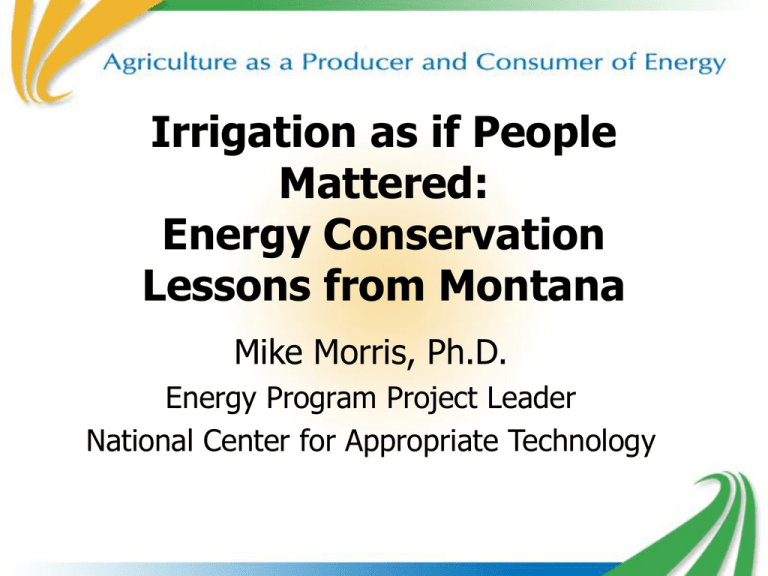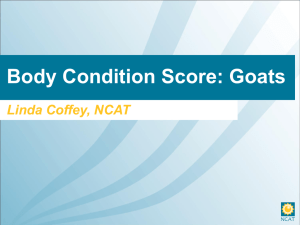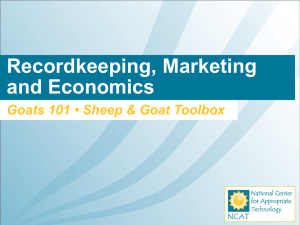Irrigation as if People Mattered: Energy Conservation Lessons from Montana
advertisement

Irrigation as if People Mattered: Energy Conservation Lessons from Montana Mike Morris, Ph.D. Energy Program Project Leader National Center for Appropriate Technology 1 About NCAT National non-profit organization, founded in 1976. Main offices: Butte, MT, Fayetteville, AR, Davis, CA 2 Programs: Sustainable Agriculture, Energy, Communities This talk will • Describe how Montana irrigators use energy. • Offer lessons learned from five approaches to energy conservation. 3 Main Conclusions • Irrigation efficiency is not just a technical problem, but has intrinsic human and social dimensions. • Irrigators welcome energy conservation but usually 4 view it as a secondary consideration. Montana Climate and Crops • 10-20” rain and 100-150 frost-free days in most areas. • Top five crops by cash receipts: wheat, barley, sugar beets, hay, potatoes. • Half of irrigated acreage is hay, ¾ of hay acreage is alfalfa. 5 Irrigation Methods • Only 5% of farmland (2 million acres) is irrigated. • Of irrigated acreage, only 1/3 is sprinkler-irrigated. • Half of sprinkler-irrigated acreage under pivots. • 93% of irrigated acreage irrigated by surface water. • 92% of irrigation pumps electric-powered. 6 Water Availability • Most irrigators pay nothing for water. • Chronic water shortages the rule, not the exception. • Water law limits opportunities for conservation. • Informal arrangements, peer pressure often more 7 important than legal constraints. Energy Costs • Electric rates low by national standards, but sharp increases in recent years. • Average $14.68 - $23.41 per pump-irrigated acre. • NorthWestern Energy 2003-4 irrigation rates: $8.03 per kW peak demand and $.043 per kWh.8 2002 Crop Values per Acre Potatoes $2,928 Alfalfa hay $315 All hay $278 Wheat $190 Sugar beets Corn Barley Oats $856 $296 $193 $151 9 Average Irrigation Energy Cost as a Percentage of Crop Value Potatoes 0.7% Alfalfa hay 7.4% All hay 8.4% Wheat 12.3% Sugar beets 2.7% Corn 7.9% Barley 12.1% Oats 15.5% “It’s the crop, stupid.” 10 Labor Cost and Availability Average pivot irrigation project cost $67,264, with energy savings of $1,271 per year. 11 Five Approaches to Energy Conservation 1. Energy Audits 12 NCAT Experience • Over 400 irrigation energy audits since 1988. • Currently offering no-cost energy audits to NorthWestern Energy irrigation customers. • Measure pressure, flow rate, electrical power output; calculate pumping plant efficiency. • Customer receives report with recommendations, payback, power bill analysis, incentive offers. 13 Most Common Energy-Saving Recommendations from Audits • Replace worn nozzles • Repair leaks • Correct motor overloading problems • Rebuild pump and/or motor • Replace pump and/or motor • Correct discharge problems • Correct suction problems 14 Lessons Learned • Audits are highly appreciated, sometimes desperately needed. • Labor intensive (average cost $672 per audit). • Only about half of participants completed recommended improvements within 1 year. • Equipment improvements do not necessarily lead to energy savings. 15 2. Direct Financial Incentives 16 NCAT Experience • Administering cost-sharing program for NorthWestern Energy irrigation customers. Most common customer project proposals in 2003: • Replace hand or wheel lines with pivots (15) • Replace high-pressure pivot w/low-pressure (8) • Use gravity to reduce horsepower requirements (3) • Replace oversized or inefficient pumps (2) • Install variable frequency drives (2) 17 Lessons Learned • Dollar for dollar, direct incentives save more energy than audits. • Evaluation criteria need to be carefully designed for consistency and fairness. • Working closely with local equipment dealers a key to success. • Gravity conversion is probably the biggest energy conservation opportunity remaining in Montana’s irrigation sector. 18 3. Soil Moisture Monitoring 19 The M. K. Hansen AM400 Soil Moisture Data Logger 20 NCAT has helped install over 120 soil moisture monitoring systems since 2000. 21 22 23 Lessons Learned • Pivot systems offer the best opportunities for conservation through improved management. • Poor management is common, but gross overwatering is less frequent than expected. Only 3-6 of 43 study fields clearly exceeded annual alfalfa water requirements. • Better water management should be promoted primarily in terms of crop yield and crop health. 24 4. Educational Publications • In 2003 NCAT revised and reprinted the Montana Irrigator’s Pocket Guide. • NCAT has contracted with NRCS to produce a national edition. 25 5. Collaboration with Local Watershed Groups 26 NCAT Experience • Working with local groups in river valleys with chronic water shortages: Big Hole, Blackfoot , Boulder, Jefferson, Ruby, and Shields. • Goal is to help each group organize and run its own irrigation efficiency program. 27 28 Lessons Learned • Learning in rural communities takes place by imitation and word of mouth. • Groups vary widely. • Progress on irrigation management is most likely to come from locally-based projects that enable irrigators to experiment on their own and learn from each other. 29 For More Information • NCAT: www.ncat.org 1-800-ASK-NCAT • National Sustainable Agriculture Information Service: www.attra.ncat.org 1-800-346-9140 30





